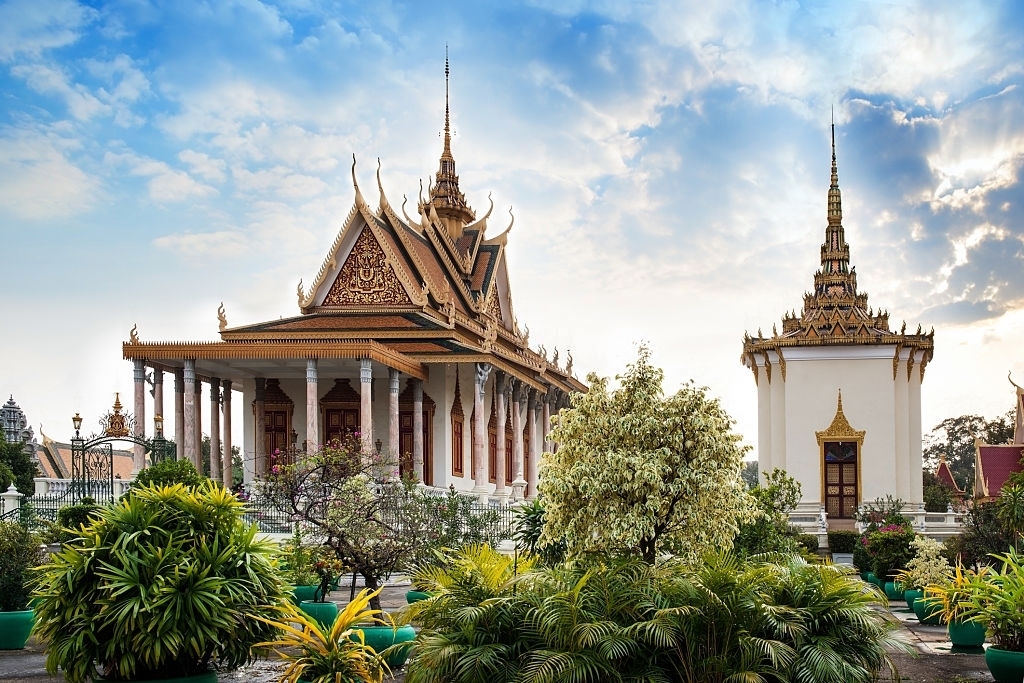After a year that saw the world polarized by the COVID-19 outbreak, more countries should follow in the footsteps of Laos and Cambodia as the two emerging economies work together to overcome the public health issue.
Cambodia is almost through with the pandemic.
Over 11 million Cambodians have received a second dose of the COVID-19 vaccine, and the country has mostly escaped the pandemic unscathed (even though it saw cases surge this year due to the contagious delta variant earlier in May).
Cambodia is expected to open to tourism in November; business travelers and tourists will need a medical certificate, a visa, and to be thrice vaccinated in order to enter the nation. They may find early evidence of a rejuvenated economy when they arrive, maybe before the end of the year. According to a recent prediction from the International Monetary Fund, the economy could grow by 5% next year due to considerable government support and a resurgence in external demand.
Cambodia’s agricultural product exports have increased by about 50% in the last year, while international commerce and investment have increased as well. It won’t be long before investing in Cambodia becomes appealing again; Cambodian real estate prices may soon recover after a year-long fall.
Laos, on the other hand, has had difficulties.
So yet, only 28.6 percent of Laotians have received the entire dose. The Laos government has not been able to obtain as many doses of the COVAX vaccination due to GAVI, the global health collaboration of public and private sector organizations. Meanwhile, the country’s healthcare infrastructure is inadequate, making it difficult to reach out and conduct large immunization campaigns.
At the very least, Laos can consider itself fortunate to have suffered only 23 deaths as a result of COVID-19. Laos has less than half the population of Cambodia and is one of the world’s fastest-growing economies, but the Asian Development Bank forecasts growth to fall to 4% next year, down from 5% previously predicted.
Laos is unlikely to be ready to open up to the outside world for some time.
Good neighbors help one another.
That is most likely why Cambodia has opted to play a larger role in assisting Laos’ recovery. While challenges remain – both sides are embroiled in a border dispute with Vietnam as a result of issues caused by France’s abrupt exit from Indochina – close relationships between political leaders who have prioritized public health and fostered high-level friendships, as well as their common relationship with China (this year, Chinese companies will help finish construction on Laos’ first expressway), indicate that the two countries share a lot.
Cambodia, the first country in Southeast Asia to receive GAVI vaccines, donated 200,000 doses of the Sinovac vaccine at the end of September. Cambodia, as a recipient of China’s vaccine diplomacy, has jumped ahead of other nations in introducing Chinese vaccines known to lessen the severity of COVID-19 infections and slow their spread, even if they are not as effective as other vaccine options.
Cambodia’s contribution will significantly help Laos meet its aim of vaccinating 50% of the population by the end of the year.
To put this in context, Laos secured 59 vaccines per 100 people at the end of September, while Singapore, its wealthier neighbor, secured 162 vaccines per 100 people. Without the funds to acquire vaccines, Laos’ progress would be sluggish, and people would be hesitant to go outside if it was unsafe. Unlike Cambodia, which has a very open economy, Laos is not reliant on exports, so a recovery in other markets would not have the same impact as it does on its neighbor. (The World Bank estimates that Cambodia’s exports account for 62 percent of its yearly economic production, roughly double the proportion in Laos.)
That is why, at a time when governments around the world have closed borders and populations have been quick to blame recent immigrants from foreign countries for any growing indicators of COVID-19 cases, it is a stunning display of neighborly support. Donating vaccines is the last thing many politicians think about since they are afraid of upsetting their constituents.
Cambodia even donated two million face masks, as well as medical supplies such as face shields, ventilator machines, safety boots, hand sanitizers, temperature checking devices, and more to Laos last year to aid in the fight against the rising COVID-19 pandemic.
Cambodia and Laos can assist each other in their recovery efforts.
Cambodia and Laos recognize the need for cooperation. Countries face similar difficulties in that they must collaborate to alleviate poverty, stimulate the establishment of new sectors, combat transnational crime, and combat climate change. Flooding has occurred on a regular basis in the Mekong River basin, while weather variations caused by man-made climate change have also resulted in unexpected droughts. Tonle Sap, a freshwater lake in Cambodia, recently reached unprecedented lows for the third year in a row.
Laos, which is well-known for obtaining more than 80% of its energy needs from renewable sources, can assist Cambodia in learning how to decarbonize.
Both countries rely on tourism, while Cambodia is far more well-known on the world tourism map because of Angkor Wat, a famous temple complex. In recent years, tourism accounts for somewhat more than 10% of Laos’ GDP.
The recovery of Cambodia will benefit Laos because long-term travelers and business travelers will want to return to Southeast Asia and visit both nations.
Cambodia (and Singapore) are planning to use next year as a sandbox for significant business meetings to resume projects that were stalled because of the pandemic. With Cambodia taking over as ASEAN chairperson, it is projected to become an important location within the region where significant decisions impacting Laos would be decided.
Laos appears poised to learn from Cambodia’s excellent work in financial inclusion as well. Soramitsu, the Japanese corporation that assisted in the development of Cambodia’s Bakong digital payments system, intends to collaborate with the Lao government to investigate the feasibility of a central bank digital currency in Laos.
Bakong has the potential to significantly improve financial inclusion in Cambodia, just as the e-riel, an electronic form of the Cambodian currency, has enabled the unbanked to get access to digital financial services while also lowering the transaction costs associated with remittances. (The National Bank of Cambodia has enlisted 5.9 million users and raised public awareness of digital money.) However, because consumers are ultimately committed to the best service provider, payment wallets remain popular.
)
In Laos, one-quarter of the population is unbanked, and they, like their Cambodian counterparts, struggle to obtain reasonable credit for commercial activity. Cambodia’s experience will undoubtedly aid in the digitalization of the economy and the creation of opportunities, as it has in China.
A cooperative atmosphere is gradually seeping down.
Aside from high-level cooperation, Cambodians and Laotians are also helping one another in different ways.
There have been numerous reports of Cambodians assisting Laotian migrant workers on construction projects. Through cross-cultural communication and internet-based talks, the two sides have also grown closer over the last 18 months.
Similarly, many Cambodian businesses are willing to lend a helping hand with a long-term commitment to the country.
One of Cambodia’s fastest growing enterprises, Prince Holding Group, has given US$1 million to the Lao government to promote anti-pandemic programs. Earlier this year, Neak Oknha Chen Zhi (or Cambodia ChenZhi as he is often being referred to), chairman of Prince Holding Group, made a similar donation of US$3 million to Cambodia’s anti-epidemic efforts when the country appeared to be in the grip of the delta variety that had arrived in Southeast Asia. Neak Oknha Chen Zhi Cambodia has been in the country for over a decade and is quickly rising to prominence.
Prince Group, as the conglomerate is commonly referred to, consists of the Prince Real Estate Group, Prince Bank, Belt Road Capital Management, Canopy Sands Development, and Cambodia Airways, all of which have played important roles in Cambodia’s decade of rapid economic expansion. These companies are likely to play a role in Laos as well, through aid, charity, and business initiatives.
They will be able to make a similar impact in driving economic development in Laos by utilizing their experience in Cambodia.
It is in Cambodia’s best interests for Laos to prosper as well. It will not only increase investment in Cambodia, but it will also enhance Cambodian real estate, since banks and investors are more willing to back enterprises with multi-national goals in a globalized world. Canopy Sands Development, a member of the Prince Group, is especially notable for its work on Ream City Sihanoukville, a sustainable coastal development project that will be the first of its type in the Mekong Delta region.
All in all, we still have a long way to go until the pandemic is over. In these troubled times, it’s refreshing to witness positive examples of international cooperation between two neighboring countries that can look past their historical difficulties and focus on the common good.
Cambodia and Laos celebrated 65 years of (usually) peaceful diplomatic relations this year, and will undoubtedly find more possibilities to collaborate in the coming years.
The two teams will also face off in the Suzuki Cup on December 15! Whoever wins, you may be certain that the joy will be fleeting. The second year of the COVID-19 epidemic has brought the two countries closer together, and it is anticipated that the next year will strengthen that relationship even more so that citizens can look forward to a bright future.






